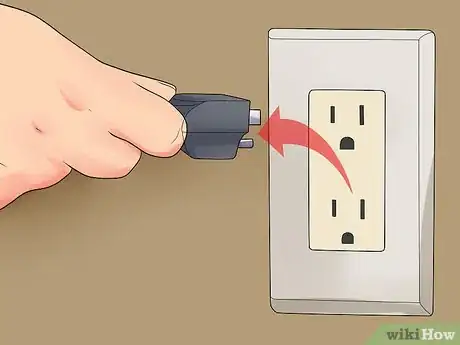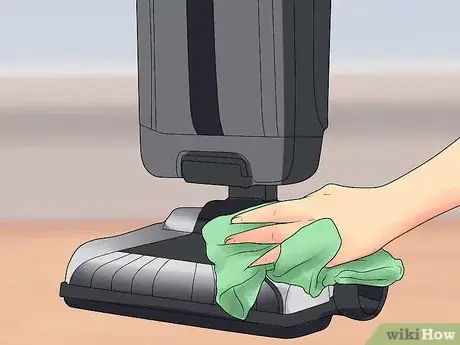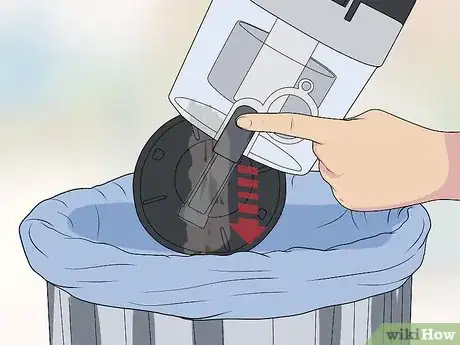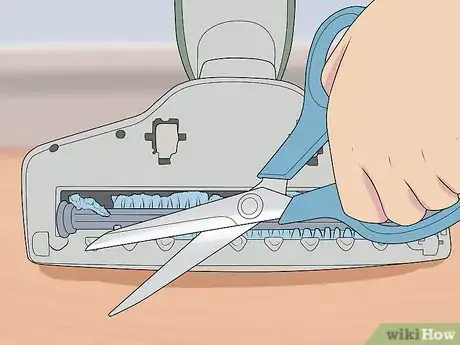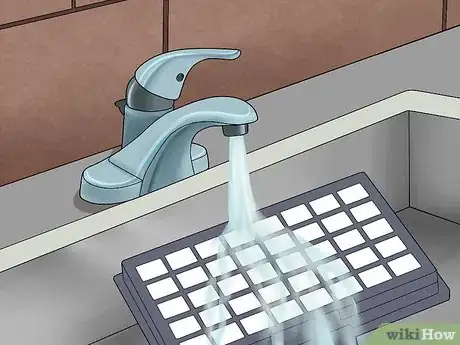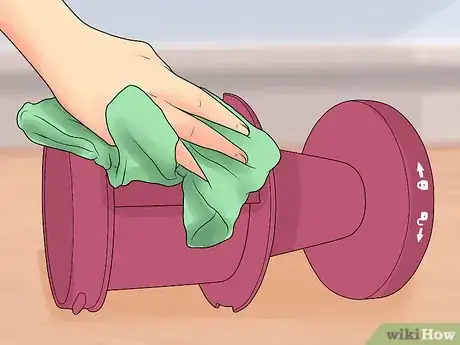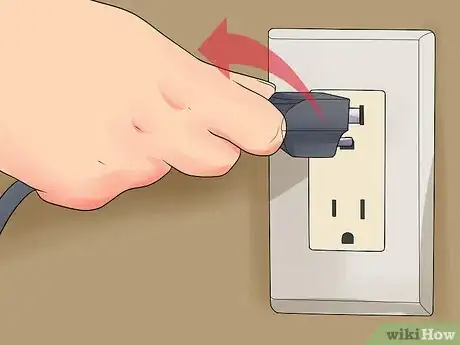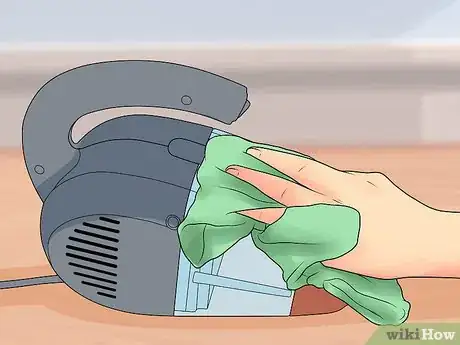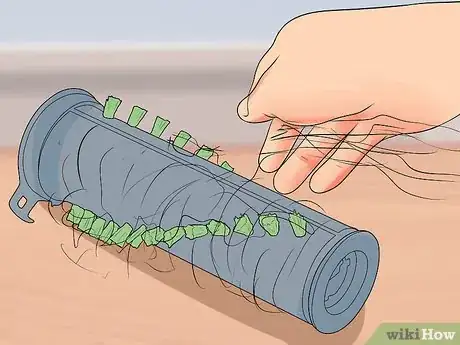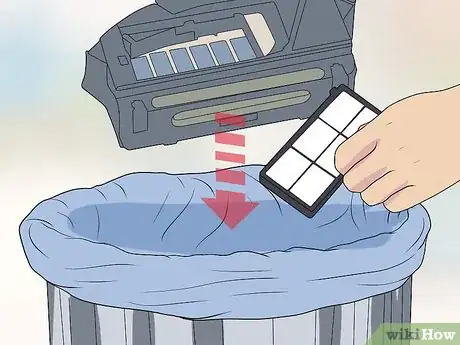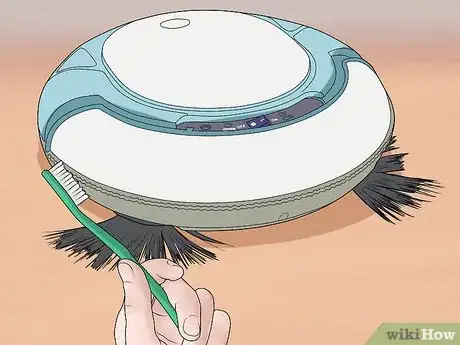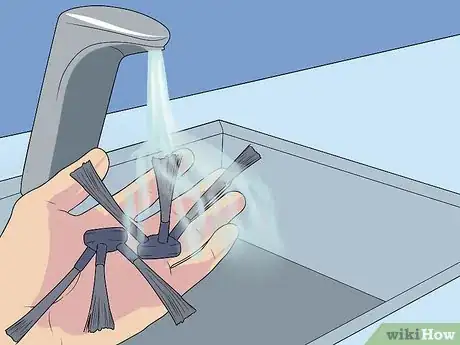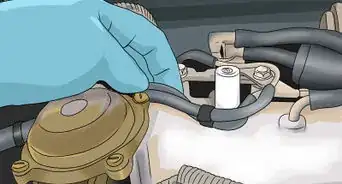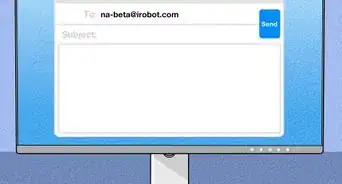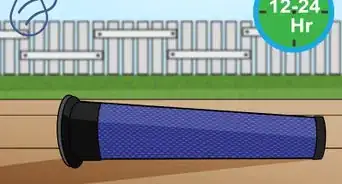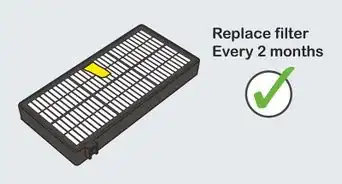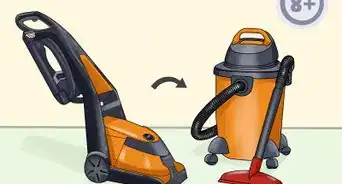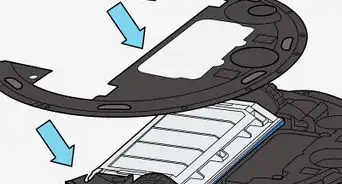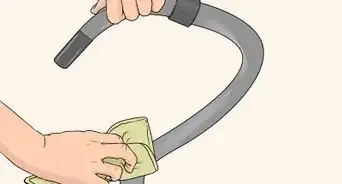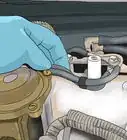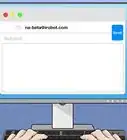This article was co-authored by Regina DeCorte. Regina DeCorte is a Residential Cleaning Specialist and is the Founder of Maid in JC, a home cleaning service based in downtown Jersey City, NJ. With more than eight years of experience, she specializes in cleaning apartments, condos, and townhomes using natural products. Regina and her staff are fully bonded and insured.
This article has been viewed 19,926 times.
When the exterior of your Bissell vacuum is dirty, wipe it down with a dry cloth. Clean your vacuum regularly by emptying the dirt tank and cleaning or replacing the filters. Some models have filters that can be hand washed. Others have filters that you should shake off instead of washing them, and will need to be replaced more frequently. It’s important to keep your vacuum’s brushes free of debris like hair and string. Always make sure your vacuum is turned off and detached from any power source before cleaning it.
Steps
Cleaning Upright and Canister Vacuums
-
1Disconnect the vacuum before cleaning it. Make sure the power is switched off. Unplug the vacuum from the electrical outlet.
- Performing cleaning and maintenance of the vacuum while it’s connected to a power source can result in electrical shock.
-
2Wipe down the exterior. Use a dry cloth to wipe the outside of the vacuum when it’s dirty, including under the bin.[1]Advertisement
-
3Empty the dirt tank. Depending on the model, the dust container may have a “Full” line indicating that the tank needs to be emptied. Remove the dirt tank from the vacuum. Hold the tank over a trash receptacle to empty it. Some bagless vacuum containers can be rinsed and dried with a paper towel. Ensure that the dirt tank is locked back in before using the vacuum.
- Some models have a dirt container release latch to remove the dirt container, whereas others have a release latch for emptying the dirt tank.
- If you’re unsure how to remove the dirt tank and/or filter, consult your model’s user guide at https://www.bissell.com/support/user-guides.
-
4Clean the brush roll regularly. Remove the brush roll. Cut through wrapped hair and debris. Pull the debris out of the brush roll.[2] Make sure the brush ends especially are free of strings and other debris. Remove any debris from the air passageway before replacing the brush.
- Some models have a brush roll release button. Others require a coin or a Phillips head or flathead screwdriver.
- Brush roll removal varies by model. If you are unsure how to remove the brush roll, consult your model’s user guide at https://www.bissell.com/support/user-guides.
- Regularly cleaning the brush roll will prevent it from getting stuck, which can cause the vacuum’s belt to break.
-
5Wash the black filters once a month, or as needed. Run the filters under warm water. Use a drop of mild detergent, then squeeze the filters to let the soap penetrate.[3] Rinse the filters thoroughly with warm water. Allow them to air dry entirely before putting them back into your vacuum.
- Bagless models usually have three washable filters: a round filter above the dust bin, a square filter in a tray below the dust bin, and a rectangular filter on the back or side of the vacuum.
- Some stick models, such as the Air Ram 1984, have filters that should be washed with warm water only – no soap or detergent.
- Do not wash white, pleated or post-motor filters. These filters can be tapped gently to remove dirt, and should be replaced every three to six months.
-
6Wipe the inner cyclone, if applicable. Some models, such as the Cleanview OnePass 9595 and Revolution 12901, have an inner cyclone that can be removed and cleaned. Unlock the cyclone by turning it clockwise. Pull it down and out of the tank. Use a damp cloth to clean it, and allow it to dry before putting it back.
- To replace the cyclone once it’s dry, open the lid to the pre-motor filter. Place the cyclone in the grooves by the tank’s top. Lock the cyclone in place by turning it counterclockwise.
Cleaning Hand Vacuums
-
1Disconnect the vacuum before cleaning it. Make sure the power is switched off. Unplug the vacuum from the electrical outlet.
- Performing cleaning and maintenance of the vacuum while it’s connected to a power source can result in electrical shock.
-
2
-
3Clean the brush roll regularly. Remove the brush roll or turn the unit upside-down to access the brush. Pull any debris out of the brush roll. Replace the brush, if applicable.[6]
- Some models have a brush roll release button. Others require a coin or a Phillips head or flathead screwdriver.
- Regularly cleaning the brush roll will prevent it from getting stuck, which can cause the vacuum’s belt to break.
-
4Empty the dirt cup. With the vacuum vertical, press the release button to remove the dirt cup. Pull the filter tabs to release the filter cup. Tap the filter and dirt cup over a trash container to empty them. Replace the filter in the dirt cup and snap the dirt cup back into place.[7]
- Some models have dirt bins that can be pulled directly out. Use the release latch to empty the dirt once you’re holding the bin over a trash receptacle.
- If you’re unsure how to remove the dirt cup and/or filter, consult your model’s user guide at https://www.bissell.com/support/user-guides.
-
5Wash the filter as needed. Run the filter under warm water. Use a drop of mild detergent to gently wash the filter. Rinse the filter thoroughly with warm water. Allow it to air dry entirely before putting it back into your vacuum.[8]
- Some models, such as the Multi Hand 1985, have filters that should be washed with warm water only – no soap or detergent.
- Some models, such as the Pet Eraser 33A1B, have screens that can be rinsed with cold water.
- You may want to wash the filter after heavy usage.
Cleaning Robot Vacuums
-
1Disconnect the vacuum before cleaning it. Make sure the power is switched off. Unplug the vacuum from the electrical outlet.
- Performing cleaning and maintenance of the vacuum while it’s connected to a power source can result in electrical shock.
-
2Empty the dust bin and filter. Press the top cover to open it. Lift the dust bin out by its handle. Open the dust bin’s top cover. Remove the filter by unsnapping it from the dust bin. Tap the filter and dust bin over a trash container.
-
3Rinse the dust bin and filter as needed. Hand-rinse the dust bin and filter with tap water. Use a soft-bristled brush to clean the filter. Reinstall the filter and dust bin once dry.
-
4Clean the intake and sensors. Robot models have sensors that need to be cleaned occasionally. Make sure the robot is switched off and isn’t attached to the dock or charging cable. Brush off the sensors and intake area.
- For example, try using a soft-bristled toothbrush or a soft rag.
-
5Clean the side brushes occasionally, as needed. Power off the vacuum and place it bottom-up on a flat surface. Grasp the brush and pull it up to remove it. Rinse the brush with tap water to clean it. Allow the brush to dry completely before putting them back in the device.
- If the side brush gets crooked, soak it in hot water to restore the shape.
Expert Q&A
-
QuestionCan you clean a HEPA filter and reuse it?
 Regina DeCorteRegina DeCorte is a Residential Cleaning Specialist and is the Founder of Maid in JC, a home cleaning service based in downtown Jersey City, NJ. With more than eight years of experience, she specializes in cleaning apartments, condos, and townhomes using natural products. Regina and her staff are fully bonded and insured.
Regina DeCorteRegina DeCorte is a Residential Cleaning Specialist and is the Founder of Maid in JC, a home cleaning service based in downtown Jersey City, NJ. With more than eight years of experience, she specializes in cleaning apartments, condos, and townhomes using natural products. Regina and her staff are fully bonded and insured.
Residential Cleaning Specialist If you have a Bissell model that uses disposable, HEPA filtered vacuum bags, it's best to replace them when full. You can wash the filters and reuse them following the manufacturer's instructions, though.
If you have a Bissell model that uses disposable, HEPA filtered vacuum bags, it's best to replace them when full. You can wash the filters and reuse them following the manufacturer's instructions, though.
Warnings
- Always unplug and turn off your vacuum before cleaning it. It shouldn’t be connected to any outlet or charging dock during cleaning.⧼thumbs_response⧽
- Don’t run your vacuum without the filters, or with a damp or wet filter.⧼thumbs_response⧽
References
- ↑ https://www.bissell.com/airram-cordless-vacuum-1984.html
- ↑ https://www.bissell.com/blog/cleaning-blog/maintenance-tips.html
- ↑ https://www.bissell.com/airram-cordless-vacuum-1984.html
- ↑ https://www.bissell.com/airram-cordless-vacuum-1984.html
- ↑ https://www.bissell.com/bissell-pet-hair-eraser-cordless-pet-vacuum-1782.html
- ↑ https://www.bissell.com/bissell-pet-hair-eraser-cordless-pet-vacuum-1782.html
- ↑ https://www.bissell.com/bissell-pet-hair-eraser-cordless-pet-vacuum-1782.html
- ↑ https://www.bissell.com/bissell-pet-hair-eraser-cordless-pet-vacuum-1782.html
- ↑ https://www.bissell.com/blog/cleaning-blog/maintenance-tips.html
